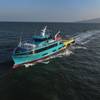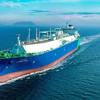Classification society Bureau Veritas has developed guidelines for walk-to-work (W2W) motion compensated Offshore Access Systems (OAS) which are used to transfer industrial personnel to and from offshore installations. Guidance Note NI629 Certification of Offshore Access Systems provides a clear and comprehensive overview of the safety principles and technical requirements for the design, manufacturing and operation of reliable and dependable equipment for the safe transfer of personnel at sea.
Matthieu de Tugny, Senior Vice-President and Head of Offshore, Bureau Veritas, said, "Getting people safely onto and off unmanned platforms and wind farm towers offshore has become a big issue. Walk-to-Work OAS can provide significant safety, operability and/or cost advantages over more traditional personnel transfer methods such as personnel basket or capsule lifts, step-over from high speed crew transfer vessels and helicopter transfers. We see a lot of new vessel types emerging with these motion-compensated gangways and it is imperative that the industry has a standard against which to assess their safety and to help develop safe new designs.”
Two different offshore access technologies have emerged: passive transfer gangways, which are first connected to the offshore installation and then put in free-flow mode for personnel transfer, and active transfer gangways which remain motion compensated during personnel transfer. The safety issues and critical components, which differ from one category to the other, require special attention to ensure safe and reliable operation.
“With these new guidelines the regulatory gap into which personnel transfer between offshore support vessels and offshore installations could fall has been closed,” de Tugny said.











